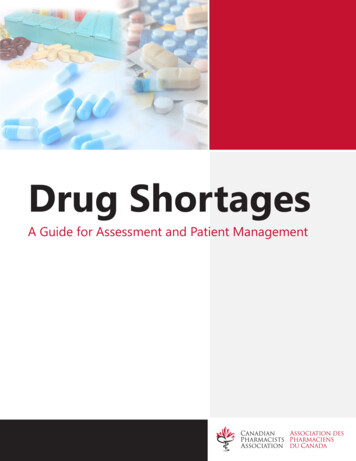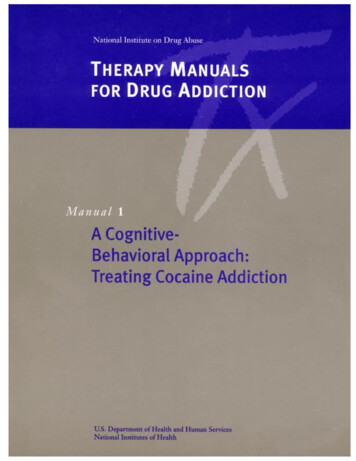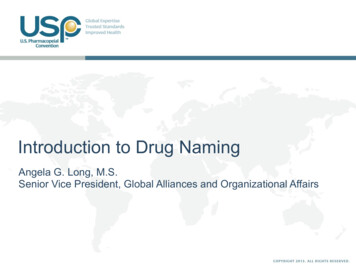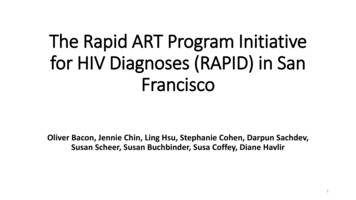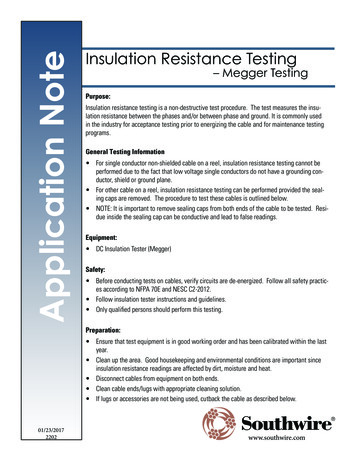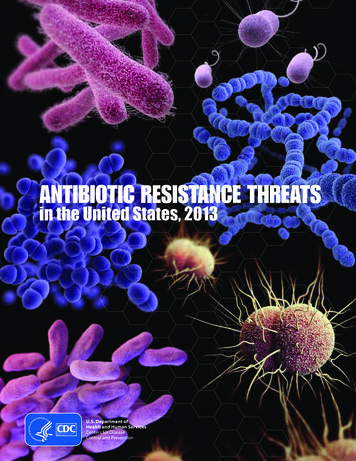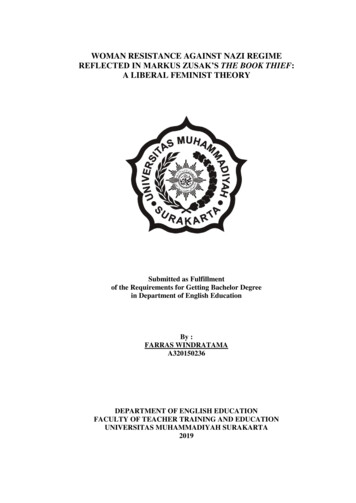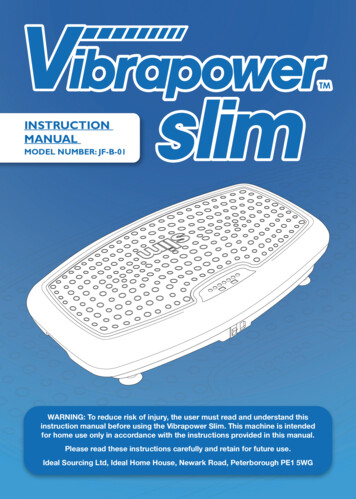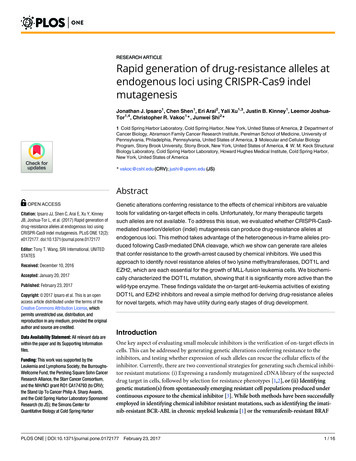
Transcription
RESEARCH ARTICLERapid generation of drug-resistance alleles atendogenous loci using CRISPR-Cas9 indelmutagenesisJonathan J. Ipsaro1, Chen Shen1, Eri Arai2, Yali Xu1,3, Justin B. Kinney1, Leemor JoshuaTor1,4, Christopher R. Vakoc1*, Junwei 11111111111 Cold Spring Harbor Laboratory, Cold Spring Harbor, New York, United States of America, 2 Department ofCancer Biology, Abramson Family Cancer Research Institute, Perelman School of Medicine, University ofPennsylvania, Philadelphia, Pennsylvania, United States of America, 3 Molecular and Cellular BiologyProgram, Stony Brook University, Stony Brook, New York, United States of America, 4 W. M. Keck StructuralBiology Laboratory, Cold Spring Harbor Laboratory, Howard Hughes Medical Institute, Cold Spring Harbor,New York, United States of America* vakoc@cshl.edu (CRV); jushi@upenn.edu (JS)AbstractOPEN ACCESSCitation: Ipsaro JJ, Shen C, Arai E, Xu Y, KinneyJB, Joshua-Tor L, et al. (2017) Rapid generation ofdrug-resistance alleles at endogenous loci usingCRISPR-Cas9 indel mutagenesis. PLoS ONE 12(2):e0172177. doi:10.1371/journal.pone.0172177Editor: Tony T. Wang, SRI International, UNITEDSTATESReceived: December 10, 2016Accepted: January 20, 2017Published: February 23, 2017Copyright: 2017 Ipsaro et al. This is an openaccess article distributed under the terms of theCreative Commons Attribution License, whichpermits unrestricted use, distribution, andreproduction in any medium, provided the originalauthor and source are credited.Data Availability Statement: All relevant data arewithin the paper and its Supporting Informationfiles.Funding: This work was supported by theLeukemia and Lymphoma Society, the BurroughsWellcome Fund, the Pershing Square Sohn CancerResearch Alliance, the Starr Cancer Consortium,and the NIH/NCI grant RO1 CA174793 (to CRV);the Stand Up To Cancer Philip A. Sharp Awards,and the Cold Spring Harbor Laboratory SponsoredResearch (to JS); the Simons Center forQuantitative Biology at Cold Spring HarborGenetic alterations conferring resistance to the effects of chemical inhibitors are valuabletools for validating on-target effects in cells. Unfortunately, for many therapeutic targetssuch alleles are not available. To address this issue, we evaluated whether CRISPR-Cas9mediated insertion/deletion (indel) mutagenesis can produce drug-resistance alleles atendogenous loci. This method takes advantage of the heterogeneous in-frame alleles produced following Cas9-mediated DNA cleavage, which we show can generate rare allelesthat confer resistance to the growth-arrest caused by chemical inhibitors. We used thisapproach to identify novel resistance alleles of two lysine methyltransferases, DOT1L andEZH2, which are each essential for the growth of MLL-fusion leukemia cells. We biochemically characterized the DOT1L mutation, showing that it is significantly more active than thewild-type enzyme. These findings validate the on-target anti-leukemia activities of existingDOT1L and EZH2 inhibitors and reveal a simple method for deriving drug-resistance allelesfor novel targets, which may have utility during early stages of drug development.IntroductionOne key aspect of evaluating small molecule inhibitors is the verification of on-target effects incells. This can be addressed by generating genetic alterations conferring resistance to theinhibitors, and testing whether expression of such alleles can rescue the cellular effects of theinhibitor. Currently, there are two conventional strategies for generating such chemical inhibitor resistant mutations: (i) Expressing a randomly mutagenized cDNA library of the suspecteddrug target in cells, followed by selection for resistance phenotypes [1,2], or (ii) Identifyinggenetic mutation(s) from spontaneously emerging resistant cell populations produced undercontinuous exposure to the chemical inhibitor [3]. While both methods have been successfullyemployed in identifying chemical inhibitor resistant mutations, such as identifying the imatinib-resistant BCR-ABL in chronic myeloid leukemia [1] or the vemurafenib-resistant BRAFPLOS ONE DOI:10.1371/journal.pone.0172177 February 23, 20171 / 16
Generation of rare drug-resistance alleles using CRISPR-Cas9 indel mutagenesisLaboratory (to JBK); and by the Cold Spring HarborLaboratory Women in Science Award (to LJ). LJ isan investigator of the Howard Hughes MedicalInstitute.Competing interests: The authors have declaredthat no competing interests exist.mutants in melanoma [4], some limitations still persist. For example, achieving the properexpression level of the ectopically expressed cDNA is critical to confer resistance. Moreover,spontaneous mutations that confer resistance may occur in genes unrelated to the drug’s directtarget, as is the case in mutations that induce an up-regulation in transporter proteins that canpump the inhibitor out of the cell.Here, we present a simple method that employs CRISPR-Cas9 (clustered regularly interspaced short palindromic repeats) mutagenesis to derive resistance-conferring alleles of endogenous genes for demonstrating the on-target effects of compounds in cells. CRISPR-Cas9is an RNA-guided endonuclease system that is widely used for genome editing [5,6]. In thissystem, a programmable single guide RNA (sgRNA) directs a Cas9 protein to desired genomicregions and produces a double-strand DNA break (DSB). Through the error-prone nonhomologous end joining repair pathway, a collection of indel mutations are introduced toregions flanking the Cas9-mediated DSB site [7–9]. Directing these CRISPR-induced indelmutations to protein-coding regions generates both in-frame and frame-shift mutations ofthe gene being targeted [10–12]. By taking advantage of functionally intact in-frame indels[11,13], we hypothesized that the diversity of indels induced by CRISPR mutagenesis could beused to select for chemical inhibitor-resistant allele(s), and subsequently, could be used forevaluating the on-target effects of corresponding chemical inhibitors. In this work, we derivedreproducible inhibitor-resistant alleles of two lysine methyltransferases (KMT), DOT1L andEZH2, through domain-focused CRISPR indel mutagenesis. Through CRISPR-based positiveselection screens, we found a recurring DOT1L mutation, VVEL293MM, which conferredresistance to a DOT1L inhibitor, EPZ-5676 [14]. Biochemical experiments suggested that theDOT1L VVEL293MM mutant was a hypermorphic mutant, as it alleviated the growth arresteffect of EPZ-5676 mainly by increasing the basal level of key methylated DOT1L substrate.Furthermore, we extended our method to identify an EZH2 mutant that rendered leukemiacells resistant to an EZH2 inhibitor, EPZ-6438 [15]. Taken together, we show that domainfocused CRISPR-Cas9 indel mutagenesis allows for a straightforward and rapid identificationof drug-resistant alleles, making it a useful tool for the evaluation of on-target drug activity.Materials and methodsPlasmidsThe constitutive, human codon-optimized, Streptococcus pyogenes Cas9 retroviral expressionconstruct (MSCV-hCas9-PGK-Puro, Addgene: #65655) and lentiviral sgRNA expression vector (LRG, Addgene: #65656) were adapted from previous work [11]. The wild-type humanDOT1L cDNA was cloned into a lentiviral expression vector with EFS prompter and P2Alinked Puromycin resistance gene. P2A, porcine teschovirus-1 2A. The wild-type EHZ2 cDNAwas cloned into an MSCV-based vector containing a puromycin-resistance gene and a GFPreporter as previously reported [16]. Both the DOT1L VVEL293MM DOT1L and EZH2TR683KK mutations were introduced by standard PCR mutagenesis. The PCR cloning procedures were performed using the In-Fusion1 HD Cloning Kit (Clontech: #638909). For therecombinant DOT1L KMT domain, wild-type and VVEL293MM mutant cDNA were clonedinto the bacterial expression vector pET-22b (Novagen) via sequence- and ligation-Independent cloning, which contained an N-terminal His6-tag and TEV protease site that allowed foraffinity purification and subsequent cleavage of the affinity tag.Single and pooled CRISPR sgRNA cloningPlasmids expressing a single sgRNA were cloned by annealing two DNA oligos and ligatinginto a BsmB1-digested LRG vector. To improve U6 promoter transcription efficiency, an extraPLOS ONE DOI:10.1371/journal.pone.0172177 February 23, 20172 / 16
Generation of rare drug-resistance alleles using CRISPR-Cas9 indel mutagenesis5’ G nucleotide was added to all sgRNAs that did not start with a 5’ G. For the pooled sgRNAstargeting the KMT domain of either DOT1L or EHZ2, all possible sgRNAs were designedbased on a PAM sequence of NGG that is recognized by the S. pyogenes Cas9 protein. ThesgRNAs were synthesized individually, annealed to complementary sgRNAs, pooled in equalmolar ratios, and ligated into BsmB1-digested LRG vectors. All sgRNA sequences used in thisstudy are provided in S1 Table.Cell culture and virus productionAll cell lines used in this study were tested as mycoplasma negative. The RN2c cell line wasadapted from previous study [11]. Briefly, murine MLL-AF9/NrasG12D acute myeloid leukemiacells (RN2) [17] were transduced with MSCV-hCas9-PGK-Puro, followed by puromycinselection. A single cell-derived clone was derived by serial dilution. RN2 and RN2c cells werecultured in RPMI1640 supplemented with 10% fetal bovine serum (FBS) and penicillin/streptomycin.Plat-E cells were used for retroviral delivery of hCas9 or EZH2 cDNA expression vectors,following standard procedures [18]. HEK293T cells were used for lentiviral production ofsgRNA or DOT1L expression vectors. Ecotropic Plat-E cells and HEK293T cells were culturedin DMEM supplemented with 10% FBS and penicillin/streptomycin. Lentivirval vectors weremixed with pVSV-G and psPAX2 in a 4:2:3 ratio using PEI reagent (Polysciences, #23966).Viral supernatants were collected at 36, 48, 60, and 72 hours post-transfection. RN2 cells weretransduced with empty or indicated cDNA overexpression vectors, followed by puromycinselection for ectopic cDNA overexpression. To measure the relative cell accumulation, cDNAtransduced RN2 cells were counted at the initial and end experimental time points using aGuava Easycyte HT instrument (Millipore). Gating was performed on live cells using forwardand side scatter together with propidium iodide to exclude dead cells. The relative cell accumulation of each experimental condition was calculated by normalizing to the untreatedcondition.Pooled sgRNA screening, Miseq library construction, and data analysisVirus containing the pooled sgRNA library was generated as described above. Serial dilutionof this virus in correlation with the GFP cell population was used to estimate the viral titermultiplicity of infection (MOI). In the initial infected cell population, the total number ofRN2c cells corresponded to an approximately 1 million-fold representation of each sgRNA. Toensure that a single sgRNA was transduced per cell, the viral volume for infection corresponded to an MOI of 0.5. At 3 days post-infection, RN2c cells were treated with chemicalinhibitors, while a small portion of the RN2c cells was harvested and used as a reference timepoint (day 0). Likewise, at later time points, when the sgRNA /GFP and inhibitor-resistantcell population emerged, a small portion of the cells was harvested again and saved for subsequent deep sequencing experiments. The sgRNA /GFP cell population was monitored overthe experimental time course using a Guava Easycyte HT instrument (Millipore). Gating wasperformed on live cells using forward and side scatter together with propidium iodide toexclude dead cells, prior to measurement.The sgRNA cassette MiSeq deep sequencing library was constructed using a similar methodas previously described [11]. Genomic DNA was extracted using QiAamp DNA mini kit (Qiagen #51304), following the manufacturer’s protocol. In order to maintain 1000-fold sgRNAlibrary representation, 20 parallel PCR reactions were performed to amplify the sgRNA cassette using the 2X High Fidelity Phusion Master Mix (Thermo Scientific #F-548). PCR products were subjected to Illumina MiSeq library construction and sequencing. First, the PCRPLOS ONE DOI:10.1371/journal.pone.0172177 February 23, 20173 / 16
Generation of rare drug-resistance alleles using CRISPR-Cas9 indel mutagenesisproduct was end repaired with T4 DNA polymerase (New England BioLabs, NEB), DNA polymerase I (NEB), and T4 polynucleotide kinase (NEB). Then, an adenosine overhang wasadded to the end-repaired DNA using Klenow DNA Pol Exo- (NEB). The overhanging DNAfragment was ligated with diversity-increased barcoded Illumina adaptors followed by sevenpre-capture PCR cycles. The barcoded libraries were pooled at an equal molar ratio and subjected to massively parallel sequencing through a MiSeq instrument (Illumina) using pairedend 75-bp sequencing (MiSeq Reagent Kit v3; Illumina MS-102-3001).The sequence data were de-barcoded and trimmed to contain only the sgRNA sequence,and subsequently mapped to the reference sgRNA library without allowing any mismatches.The read counts were calculated for each individual sgRNA. To calculate the relative abundance of each sgRNA, the read counts of each sgRNA were divided by the total read counts ofthe pooled sgRNA library. The primer and diversity-increased barcode information are listedin S1 Table.MiSeq analysis of CRISPR-induced mutationsA deep sequencing method was used to identify the DOT1L mutants associated with EPZ5676 resistance, as described previously [11]. The genomic region of DOT1L exon 8 was PCRamplified with High Fidelity 2X Phusion Master Mix (Thermo Scientific #F-548) and subjected to MiSeq library construction as described above. Barcoded libraries were pooled at anequimolar ratio and subjected to massively parallel sequencing by MiSeq (Illumina) usingpaired-end 150-bp sequencing (MiSeq Reagent Kit v2; Illumina MS-102-2002).Data analysis was performed as described previously [11]. Paired-end Illumina reads werealigned to the DOT1L genomic locus and variant sequences were called. Variant sequenceswere recorded in the tab “DOT1L mutations pooled screen” of (for the pooled sgRNA experiment) or in tab “DOT1L mutations sgRNA#47” of (for the single sgRNA experiment) S1Table,), if they were present in at least a total of 10 reads across the two time points and werenot present in the control sample.Real-time PCRRNA was prepared using Trizol reagent (Invitrogen). cDNA synthesis was performed usingqScript cDNA SuperMix (Quanta Biosciences, #101414–106). Quantitative PCR (qPCR) analysis was performed on an ABI 7900HT with SYBE green (ThermoFisher, #4309155). All signalswere quantified using the delta-Ct method and normalized to the levels of Gapdh.Expression and purification of recombinant DOT1L KMT domainThe DOT1L KMT domain constructs were transformed into E. coli BL21 (DE3)-RIPL cells forprotein expression. Cultures were grown in TB media with antibiotic at 37 C until the OD600was approximately 1.5. The cultures were then briefly cooled on ice and treated with 0.5 mMisopropyl-β-d-1-thiogalactopyranoside (IPTG) to induce protein expression. Cultures werethen incubated overnight at 16 C with shaking. After expression, the cell pellets were thawed,resuspended in 20 mM Tris, pH 8.0, 500 mM NaCl, 10 mM imidazole, 10% glycerol, 5 mMβME ( 20 mL per liter culture), and lysed by sonication. The cell lysate was clarified by ultracentrifugation at 140,000 g for 30 min and the supernatant was applied to a Ni-NTA (Qiagen)column equilibrated with lysis buffer. The bound proteins were washed with lysis buffer, further washed with lysis buffer containing 30 mM imidazole, and finally eluted in lysis buffercontaining 200 mM imidazole. The His6 tag was then removed by the addition of TEV protease (1:20 m/m ratio protease:DOT1L KMT) and overnight incubation at 4 C.PLOS ONE DOI:10.1371/journal.pone.0172177 February 23, 20174 / 16
Generation of rare drug-resistance alleles using CRISPR-Cas9 indel mutagenesisThe proteins were further purified by ion exchange chromatography using a MonoS 5/50GL column (GE Healthcare) equilibrated with 20 mM HEPES, pH 7.5, 1 mM EDTA, 1 mMDTT. Bound proteins were fractionated by elution using a gradient of NaCl from 0 to 1 M.Fractions corresponding to the target protein (around 45 mS) were pooled, concentrated, andfurther purified by gel filtration using a Superdex200 increase column (GE Healthcare) equilibrated with 20 mM HEPES, pH 7.5, 200 mM NaCl, 1 mM EDTA, 1 mM DTT.The purified protein concentrations were determined by Aλ 280 measurement and corrected for the calculated molecular extinction coefficient. The proteins were then concentratedto 10–20 mg/mL and stored at 4 C until needed. Typical yields (with 98% purity as assessedby SDS–PAGE) were 4 mg of the wild-type protein and 0.5 mg of the VVEL293MM mutantprotein per liter culture.Methyltransferase activity assayMethyltransferase activity assays with the purified DOT1L KMT domains were performed onnative nucleosome substrates purified from human HeLa cells (BPS Bioscience) using tritiatedS-adenosyl methionine (3H-SAM) (Perkin Elmer). To accurately determine the relative methyltransferase activities of the wild-type and VVEL293MM mutant proteins, serial dilutions ofthe enzymes were made under the same conditions. Each 10 μL reaction included 2 μL of3H-SAM (1 μCi, 1.3 mM final concentration) and 1 μg of the nucleosome substrate in a bufferof 20 mM Tris, pH 8.0, 4 mM EDTA, 1 mM DTT, 0.01% Triton X-100. The enzyme concentration varied as a two-fold dilution series from 100 nM to 6.25 nM. After mixing all components,the reactions were incubated at room temperature for 2 hours. Each reaction was then denatured and subjected to SDS-PAGE followed by gel fixation, treatment with ENLIGHTNINGautoradiography enhancer (Perkin Elmer), drying, and autoradiography. The dried gels werethen exposed to BioMax XAR Film (Kodak, Carestream) for approximately 60 hours. Afterdeveloping, the films were scanned and band intensities were quantified using the ImageQuantTL 8.1 analysis software package (GE Healthcare). The presented data reflect the average oftwo replicates, error bars indicate the standard error of the mean, and the linear fit of the datawas constrained to pass through the origin.Subsequently, to establish if the wild-type and mutant proteins exhibited differential sensitivity to inhibitors, similar reactions were carried out in the presence of inhibitors at a fixedprotein concentration of 50 nM. As the relative activity of the VVEL293MM enzyme wasfound to be roughly 3-fold higher than that of the wild-type protein, we sought to normalizethe total activity observed on our autoradiographs to better discern slight differences in theproteins’ sensitivity to inhibitors. To accomplish this, reactions volumes were scaled such thatthree-fold more material was loaded per gel lane for the wild-type samples. Inhibitor concentrations ranged from 400 nM to 50 nM as a two-fold dilution series. Sample processing wasperformed as described above. The integrated band intensity for the uninhibited reactions wasthen used to normalize the intensities of the inhibitor concentration series.Probing neomorphic methyltransferase activity with mass spectrometryReaction preparation. To determine if the mutant enzyme exhibits a neomorphic activitycompared to the wild-type enzyme, a proteomic analysis of the methylation reactions was performed. The nucleosome substrate (10 μg) in a buffer of 20 mM Tris, pH 8.0, 4 mM EDTA, 1mM DTT, 0.01% Triton X-100 was reacted with the DOT1L wild-type enzyme (10 μM finalconcentration) in the presence of (non-radiolabeled) S-adenosyl methionine at a concentration of 1 mM for two hours at room temperature in a reaction volume of 20 μL.PLOS ONE DOI:10.1371/journal.pone.0172177 February 23, 20175 / 16
Generation of rare drug-resistance alleles using CRISPR-Cas9 indel mutagenesisPrecipitation, digestion an
Guava Easycyte HT instrument (Millipore). Gating was performed on live cells using forward and side scatter together with propidium iodide to exclude dead cells. The relative cell ac-cumulation of each experimental condition was calculated by normalizing to the untreated condition. Pooled



